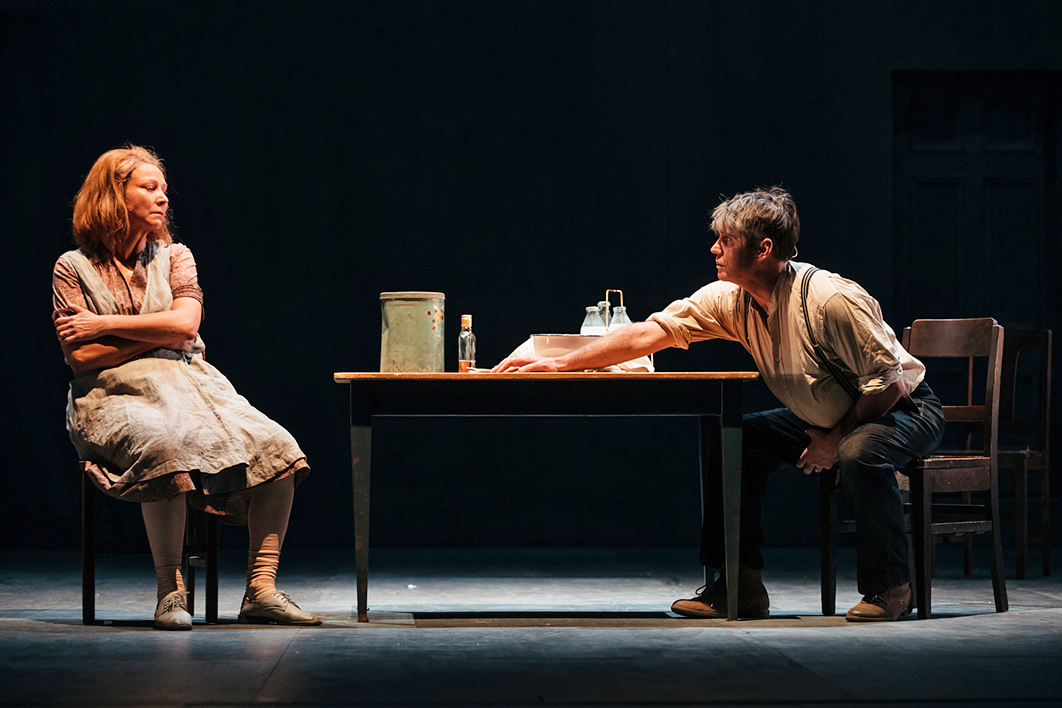Last summer the Hayes Theatre in Potts Point revived Katherine Thomson and Max Lambert’s musical Darlinghurst Nights, adapted from Kenneth Slessor’s light verse about bohemian life in the 1930s. The main storyline follows a country girl trying to survive in a poky inner-city boarding house while dealing with the low-life around her and learning the lessons of a corrupt but lively metropolis. After the show, audience members stepped out into a preserved pocket of 1930s Sydney, where they could rejoice at art deco buildings that had somehow survived each of the city’s development surges. But the energetic life that Slessor saw on the streets has disappeared: with the current lockout laws, Kings Cross on a weeknight is as quiet as a church.
Earlier in 2017 the Old Fitz Hotel down the hill in Woolloomooloo had been the venue for the first (and, so far, only) production of Louis Nowra’s This Much Is True. Though the play is the third part of Nowra’s Lewis trilogy, following the acclaimed Cosi and Summer of the Aliens, it was a perfect match for the hotel’s tiny basement theatre. Nowra depicted his local drinking mates in all their eccentricity and neediness, and after the show you might have found the author himself drinking at a table in the bar upstairs.
As theatre blogger Kevin Jackson remarked, Nowra’s play recalls the Australian naturalist plays of the 1950s in both subject and style, depicting a male underclass battling drugs, madness and poverty. It seems part of a wave of nostalgia for white inner-city poverty that pulls us back to the years before the poor moved to the outer suburbs. Despite decades of change, the ’Loo remains a pocket of extremes where film stars can be seen lining up for coffee after a morning run near the early risers from the Matthew Talbot Hostel. The hostel, along with the public housing near the Old Fitz, ensures that some of the atmosphere of poverty remains, but you have to wonder how long that will last.
A few months ago Belvoir St Theatre added Pyrmont to the list of theatre’s lost and lamented inner-city slums. Alana Valentine’s The Sugar House confronted the voracious building developments in the old industrial suburb and the loss of a human side of the city. Her story of a family of Irish-Australian Catholics making their haphazard way up the social ladder from the petty criminal underclass reminded a middle-class audience how recently their own family’s arrival in the professional classes may have been. The feisty grandmother at the play’s centre fought to protect her family, struggling to make a living and keep everyone out of the hands of the law. Her granddaughter grew up to become a successful lawyer, of course, inspecting one of the stylish apartments in The Sugar House, once the refinery where her grandfather worked and now an expensive warehouse-style block in one of Sydney’s most desirable suburbs.
This play, too, drew on the staging traditions of kitchen-sink realism, recalling Peter Kenna’s A Hard God and even Séan O’Casey’s Juno and the Paycock, with the central figure of the tough, intelligent and self-sacrificing matriarch played with her usual conviction and energy by Kris McQuade (who does tend to be typecast in these roles). Valentine tried to balance the simple moral commitment of the grandmother with the more complex political understanding of the educated granddaughter, but McQuade’s powerful performance suggested that the lost working class may have been more admirable than its educated descendants.
And so, when the Sydney Theatre Company’s The Harp in the South opened in September, it seemed like too much of a good thing — or, too much of a nostalgic thing. This ambitious two-part adaptation by Kate Mulvany of Ruth Park’s postwar novels was staged at the Roslyn Packer Theatre, itself built on the site of a pair of warehouses that once serviced the wharves across the road. Not far from the theatre, public housing tenants are being cleared from their homes and, over the road, the wharves have been transformed into some of the most luxurious apartments in Sydney. Billed as “a portrait of Sydney as it once was,” the play romanticises the old slum life in those Surry Hills terrace houses that are now worth millions.
Some of the people in the audiences for these plays have no doubt paid a great deal to live in Surry Hills, Pyrmont, Potts Point, Darlinghurst or Millers Point. Where I live, in the old slum suburb of Erskineville, the nearby industrial estate has become half a dozen apartment blocks in a matter of a few years. When I moved in, as one of the new professional apartment dwellers, the locals were still a mix of old people, migrants, Aborigines, homeless men, eccentrics and university students. In half an hour, I can walk up to the housing commission towers of Redfern and still see some of these people on the streets.
Traces of the Erskineville slums remain in the old terraces (some of them so tiny that it is hard to believe a family could ever have lived there) and the pocket parks that the Danish ballerina Hélène Kirsova set up in the 1940s when she noticed the local street urchins had nowhere to play. We’re all proud of the suburb’s history — the local Labor Party branch runs a history walk every couple of years, popular among genteel contemporary residents, that recalls violent home evictions during the Depression, the Catholic missions to the poor, and the creation of the “opportunity school.”
Theatre companies and playwrights seem to have picked up a widespread nostalgia among middle-class Sydneysiders for the suburbs that disappeared under the onslaught of their own rise in prosperity. When the first of Ruth Park’s novels was published in 1948, Sydney was suffering a major postwar, post-Depression housing crisis. Park interviewed people in the slums to produce a prime example of the kind of writing that Patrick White later derided as the “dreary, dun-coloured offspring of journalistic realism.” Her depiction of poverty was greeted with shock and horror by the good citizens of Sydney and was one of the factors that led to slum clearances in Surry Hills — and the building of those public housing towers that still stand close to Belvoir St Theatre.
The STC production is a long way from dun-coloured journalism, with the first play bright with ensemble activity and music — so much so that you almost expect it to become full-blown musical theatre. With clever staging and a large and disciplined cast, the production brings to life the novel’s soap-opera narrative of hard times, with its range of stereotypes and token figures: the good-hearted brothel madam, the quiet but generous Chinese shopkeeper, the solitary Aboriginal man making his way. There’s an unsettling figure of a deceitful Jewish boy, too. Bruce Spence, Heather Mitchell and other familiar performers relish the opportunity to show their virtuosity, with Mitchell astonishing in the Kris McQuade, Irish mother part. (Mitchell more often plays upper-class characters like A Place to Call Home’s Prudence Swanson.) The second play, however, stretched the idea too far, exposing the weaknesses of this sentimental material. The afflictions of Dolour Darcy accumulated and the music was reduced to repetition of the dirge-like “The Last Rose of Summer.”
No doubt the second play was intended to remind us that poverty is not a song-and-dance show, and to give a more overtly feminist perspective, with the nuns bowing to the priest’s power and evidence that charming Irishmen like Hughie Darcy can be feckless and generally useless to their women. Yet the warm response to the play could hardly amount to outrage at current poverty, when Sydney’s poor mainly have moved out to the fringe suburbs.
Perhaps, in a kind of remember-where-you-came-from moment, the STC was reminding its well-heeled patrons that they might be the descendants of such people (like the contemporary characters in The Sugar House). But I had the uncomfortable feeling it was celebrating the Old Australia, when the Irish immigrants were the poor and white people dominated society from bottom to top. It was a reminder of the elite nature of Australian theatre, with its blindness to popular culture and the changing life outside. There are still pockets of public housing in the inner city and the city’s homeless problem is difficult to ignore. But the inner city is overwhelmingly the province of those able to manage a hefty mortgage. Does a romantic slum past add to the pleasures of living there?
It is not only the subject matter of these plays that gives pause for thought. Their invocation of the theatre styles of the past seems to reflect a nostalgia for the kind of drama that flourished before television. As it happens, The Harp in the South has been produced twice for television — as a single play on the BBC as long ago as 1964, and by the ABC as a miniseries in 1986, with Ruth Park herself as one of the writers. The Australian director of the British version, Alan Burke, even wrote a musical version in the 1960s, but he couldn’t get it staged; he wrote the script for the musical Lola Montez and has the distinction of writing the book for Australia’s first original television musical about convicts and officers, Pardon Miss Westcott, broadcast by ATN7 in 1959.
What would be today’s equivalent of Park’s novel? SBS’s Struggle Street documentaries about the poor in Western Sydney and outer suburbs of Melbourne and Brisbane seem the nearest equivalent. Like Park’s novels, they faced the criticism that they offered up the sufferings of the poor for the entertainment of wealthier observers. Maybe the ABC’s Redfern Now series might be a better fit, with its stories about Aboriginal families struggling in the inner city, though it, too, drew on British social realist traditions. One thing television does so much better than the stage is portray material detail, particularly material deprivation, and so appeal directly to viewers’ sense of injustice.
At the Hayes, the Old Fitz and Belvoir St, the small performance spaces forced the audience into close proximity with the actors, to share at least their physical struggle to perform if not the material conditions they were portraying. The STC production explores the theatrical possibilities of the stage, dazzling us with the actors’ shifts in character and the movement of a large cast, and contents itself with mere gestures towards the material conditions of poverty. The Roslyn Packer Theatre calls for larger movements and bigger performances, and the STC’s production turns poverty in Surry Hills into bright entertainment.
Perhaps the musical is the ideal form for these nostalgic depictions of the past. Darlinghurst Nights was a delight, and Madeleine St John’s Women in Black had already become a successful musical, as Ladies in Black, before Bruce Beresford’s film finally made it to the cinemas a few weeks ago. You can enjoy the sweet simplicities of the film knowing that David Jones is still there, despite being taken over by a South African company that plans to redevelop the site. It appears that the lower floors will be preserved, sacred to our memories of shopping in one of Sydney’s last palaces of consumerism. Some developers understand the value of nostalgia. •




